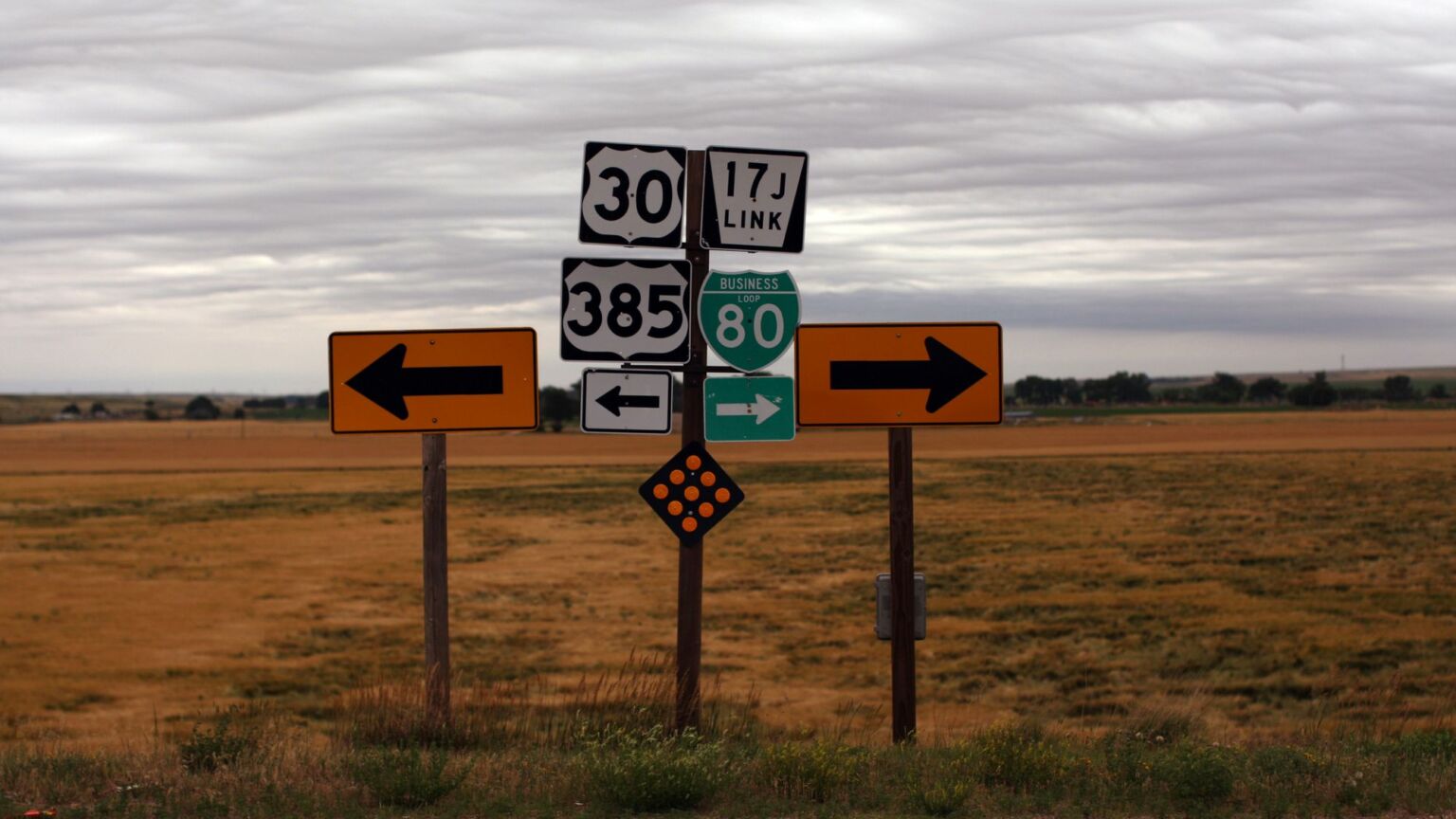A tale of two Americas
Red states are growing, while blue states are mired in lawlessness and decline.

Yesterday’s Midterms were not a victory for conservative or progressive ideology, but an assertion of the growing power of geography in American politics. It was less a national election than a clash of civilisations.
Virtually nowhere in blue areas did Republicans make gains. Both the north-east and California – the central players in Democratic Party politics – stayed solidly blue. Even the most well-regarded GOP candidates, such as Lanhee Chen who ran for California state controller, struggled to make inroads in Democratic territory.
Meanwhile, the senators and governors of the leading red states – Texas’s Greg Abbott, Georgia’s Brian Kemp, Florida’s Ron DeSantis, Ohio’s Mike DeWine – all won handily. Almost all blue-state governors remained the same as well, although the Democratic incumbents often won by smaller margins.
So, what is happening in this increasingly inexplicable country? Essentially, there are now two prevailing realities in the US. One is primarily urban, single and, despite some GOP gains in this demographic, still largely non-white. It functions on the backs of finance, tech and the service industries. The other is largely suburban or exurban, family centric and more likely involved in basic industries like manufacturing, logistics, agriculture and energy.
Usually, the media assume these two Americas represent equally viable political economies. But this is increasingly not the case. In population terms at least, red America is now growing far more rapidly than blue America. And this makes it more important politically. Since 1990, Texas has gained eight congressional seats, Florida five and Arizona three. In contrast, New York has lost five, Pennsylvania four and Illinois three. California, which now suffers higher net outbound-migration rates than most Rustbelt states, lost a congressional seat in 2020 for the first time in its history.
This decline in blue America has accelerated since the pandemic, due to rising crime and the availability of remote work. Last year, New York, California and Illinois lost more people to outbound migration than all other states. Demographer Wendell Cox notes that the largest percentage loss of residents has occurred in big core cities such as New York City, Chicago and San Francisco. In contrast, population burgeoned in sprawling areas such as Phoenix, Dallas and Orlando.
The future of the GOP depends on the continued growth of such places, as well as the growth of suburbia nationwide. Between 2010 and 2020, 51 major metropolitan areas lost 2.7million net domestic migrants from their most central counties, while suburban counties gained two million people. The Midterms show that Republicans are gaining ground in these largely suburban areas – particularly in Florida, as well as suburban Phoenix, the outskirts of Atlanta, the Houston exurbs, largely suburban Nashville, the sprawling Virginia Beach area and suburban Detroit. Democrats, where they made gains yesterday, tended to be in places like California, where the Republican Party has all but ceased to exist.
Whether Democrats like it or not, these red-leaning places, not California or New York, are where more Americans plan to settle and start families. Today, blue-state economies, based on tech and finance, generally underperform more blue-collar red economies like Texas, Arizona, Florida and Tennessee. Over the past five years, Raleigh, Phoenix, Nashville, Salt Lake City and Dallas have grown jobs at a faster rate than Silicon Valley and Seattle – and at double the rate of New York, Los Angeles and Chicago.
Investors are placing their bets in these places, too. California, easily the most important blue state, ranked near the bottom in 2020 in terms of new capital projects, and it suffered even further losses in 2021. The reshoring of basic industries like mining and manufacturing, as well as the new surge of chip production, is happening almost entirely in states like Ohio, New Mexico, Arizona and Texas. Even the green economy – so passionately embraced on the blue coasts – won’t provide many jobs there. Almost all the new electric vehicle and battery plants are located either in the Rustbelt, the south or in places east of the Sierra Nevada.
Red states are strongest at the level of small- and medium-sized firms. Last year, the biggest upsurge in new business formation took place in the deep south, Texas and the south west. Analysis by Zen Business this year found these were often the best places for small businesses – in terms of taxes, survivability and startup costs. Small business has emerged as a key GOP constituency. Almost two-thirds of small-business owners favour the Republicans.
If Democrats want to win over the next generation, these are the places future battles must take place. States like Texas, Florida and North Carolina are now the go-to places among affluent young professionals, particularly in their search for housing. Austin and Miami are also luring billionaire taxpayers, including from California. Red states – most prominently Texas and Florida – are now the country’s high-growth destinations.
Although no one wants to hear this in the cafés in Greenwich Village, political power tends to accrue to regions that are demographically and economically ascendant. Historically, this includes the frontier ascendancy led by Andrew Jackson, the Midwest ascendancy under Lincoln, the Roosevelts in New York’s golden era and, later, California’s ascendancy that sparked the rise of Richard Nixon and Ronald Reagan.
This year, the red states asserted themselves as crucial to the American political map. But long-lasting elites do not give up power easily. With the Democrats holding up better than expected in the Midterms, we can expect them to place an even greater emphasis on imposing a dogmatic Net Zero strategy, which includes the purposeful destruction of America’s huge fossil-fuel industry. This may play well in Malibu or Manhattan, but manufacturing and growing areas need abundant and affordable energy to grow.
This growing conflict played a major role in Democrat Tim Ryan’s loss yesterday to GOP Senate candidate JD Vance. Vance succeeded in part by highlighting Ryan’s embrace of the anti-fossil-fuel Green New Deal. Biden’s statement at a New York rally last week, calling for a ban on fossil fuels, could not have come at a worse time. We can expect the battle over climate policy to become more intense as the Democrats push their agenda on the rest of a mainly reluctant country.
The red / blue divide is also about two cultures. There is a largely sunbelt and suburban culture that is familial and moderate in its social views. Democrats, meanwhile, increasingly depend on largely single urbanites who embrace everything from radical transgenderism to critical race theory. This divide was on display recently when a co-host of The View compared suburban women’s shift over to the GOP to ‘roaches voting for Raid’.
Yet, remarkably, social issues that seemed to be breaking well for the Republicans – crime, education and the border – did not translate yesterday into an appreciable inroads into blue America. This is all the more remarkable given the Democrats’ embrace of the Black Lives Matter ‘defund the police’ agenda. Crime, homelessness and general disorder are soaring in these states. Policies seeking to reduce prison populations may have been well-intentioned, but they are clearly linked to rising violent crime, as habitual criminals now remain on the street. To be sure, some deep-blue cities, including San Francisco and Seattle, have now shifted to the centre on crime. But none of the major Democratic governors suffered as a result of this leniency.
Perhaps the most profound divide stems from the ever more radical social views of the Democratic base – especially when it comes to genderfluidity, new pronouns and sex-reassignment surgery. Education was long an issue that worked for Democrats, but it now favours Republicans – particularly in suburbs, where most families are located. A largely suburban parents’ revolt helped elect Virginia governor Glenn Youngkin last year. This year, the GOP has sought to benefit from parental outrage against teachers and school boards’ embrace of woke ideology and ideas like critical race theory. Critically, the parent-age Generation X is now the most solidly pro-GOP generation in the US.
Yet, as we saw in yesterday’s vote, the Democrats are not without backing. Democrats are relying more on the growing but still minority proportion of Americans who are neither married nor have children. They tend to adopt values very different from those of other key constituencies like immigrants. Overall, according to one recent survey, foreign-born Americans, who are more likely to live in two-parent families, are twice as likely as the general public to hold socially conservative views. But this has not been enough – at least outside the red states – to move minority voters decisively to the right.
Last night’s Midterms were proof that the battle between the Americas is far from over. To win, the Democrats will need to win more in red areas, since that is where the future lies. Of course, they may still be bailed out by the idiocy of Donald Trump, the only Republican who can unite the Democrats. But even if Trump returns to the frontline, the former ‘party of the people’ has a lot of work to do if it wants to build a new majority in an increasingly red America.
Joel Kotkin is a spiked columnist, the presidential fellow in urban futures at Chapman University and executive director of the Urban Reform Institute. His latest book, The Coming of Neo-Feudalism, is out now. Follow him on Twitter: @joelkotkin
Picture by: Getty.
To enquire about republishing spiked’s content, a right to reply or to request a correction, please contact the managing editor, Viv Regan.









Comments
Want to join the conversation?
Only spiked supporters and patrons, who donate regularly to us, can comment on our articles.